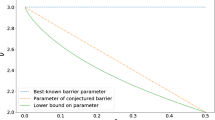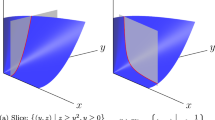Abstract
Given a self-concordant barrier function for a convex set

, we determine a self-concordant barrier function for the conic hull

of

. As our main result, we derive an “optimal” barrier for

based on the barrier function for

. Important applications of this result include the conic reformulation of a convex problem, and the solution of fractional programs by interior-point methods. The problem of minimizing a convex-concave fraction over some convex set can be solved by applying an interior-point method directly to the original nonconvex problem, or by applying an interior-point method to an equivalent convex reformulation of the original problem. Our main result allows to analyze the second approach showing that the rate of convergence is of the same order in both cases.
Similar content being viewed by others
References
E. Blum and W. Oettli,Mathematische Optimierung (Springer, Berlin, 1975).
A. Charnes and W.W. Cooper, “Programming with linear fractional functionals,”Naval Research Logistics Quarterly 9 (1962) 181–186.
D. den Hertog,Interior Point Approach to Linear. Quadratic and Convex Programming (Kluwer, Dordrecht 1994).
J.-B. Hiriart-Urruty and C. Lemaréchal.Convex Analysis and Minimization Algorithms I (Springer, Berlin, 1993).
R.W. Freund and F. Jarre, “An interior-point method for fractional programs with convex constraints,”Mathematical Programming 67 (1994) 407–440.
R.W. Freund and F. Jarre, “An interior-point method for multifractional programs with convex constraints,”Journal of Optimization Theory and Applications 85 (1995) 125–161.
R.W. Freund, F. Jarre and S. Schaible, “On interior-point methods for fractional programs and their convex reformulation” AT&T Numerical Analysis Manuscript, No. 94-17, Bell Laboratories (Murray Hill, NJ, 1994); revised October 1995; available at http://netlib.att.com/netlib/att/cs/doc/94.
F. Jarre, “Optimal ellipsoidal approximations around the analytic center,”Applied Mathematics and Optimization 30 (1994) 15–19.
F. Jarre, “Interior-point methods via self-concordance or relative Lipschitz condition,” Habilitation Thesis, Universität Würzburg (Würzburg, 1994).
Y. Nesterov and A. Nemirovskii,Interior-Point Polynomial Algorithms in Convex Programming (SIAM, Philadelphia, PA, 1994).
S. Schaible, “Parameter-free convex equivalent and dual programs of fractional programming problems,”Zeitschrift für Operations Research 18 (1974) 187–196.
S. Schaible, “Fractional programming. I. Duality,”Management Science 22 (1976) 858–867.
S. Schaible, “Duality in fractional programming: a unified approach”,Operations Research 24 (1976) 452–461.
S. Schaible, “Fractional programming,” in: R. Horst and P.M. Pardalos, eds.,Handbook of Global Optimization (Kluwer, Dordrecht, 1995) pp. 495–608.
Author information
Authors and Affiliations
Rights and permissions
About this article
Cite this article
Freund, R.W., Jarre, F. & Schaible, S. On self-concordant barrier functions for conic hulls and fractional programming. Mathematical Programming 74, 237–246 (1996). https://doi.org/10.1007/BF02592197
Received:
Revised:
Issue Date:
DOI: https://doi.org/10.1007/BF02592197




